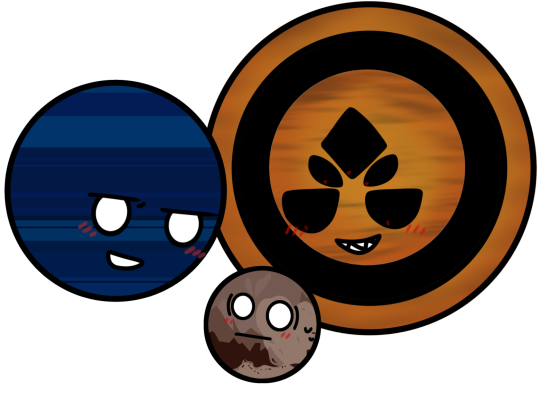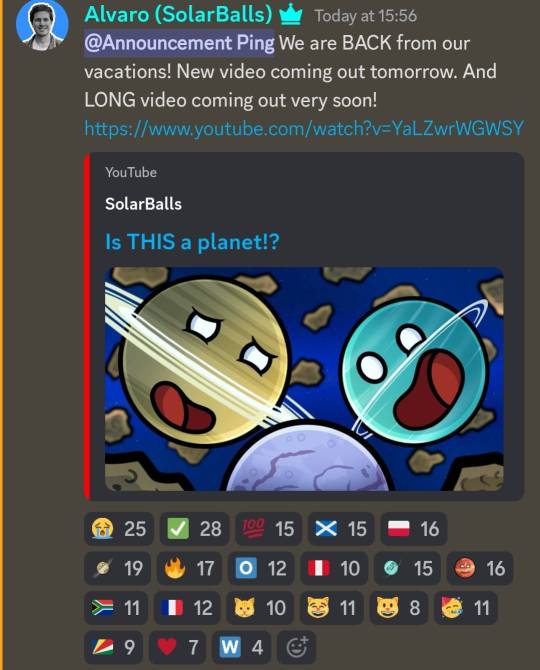#planet 9
Text

kicked out of the planet club
214 notes
·
View notes
Text
#Polls#Space#Astronomy#Planets#Pluto#Planet 9#Saturn#Earth#Venus#Mars#Mercury#Jupiter#Neptune#Uranus
155 notes
·
View notes
Text
Can you feel it?

Requested by: normal_vincey on Tiktok
#:3#solarballs#solarballs pluto#pluto#iris ghe#gemini home entertainment#Iris x pluto#planet x#Planet 9 x pluto#planet 9#Planet 9 x iris x pluto#Planet x solarballs#polyamory#can you feel it#outer space#space#I invented this ship
7 notes
·
View notes
Text

Showing the space episode of The Magic School Bus to my toddler (who was enthralled) and at the end during the call in they acknowledge that “no one knows what the surface of Pluto looks like but maybe some of you will grow up to be able to find out.”
And I just have to say:

I’m so proud of us!!!
43 notes
·
View notes
Text
errr art dump!!!





#solarballs#planet 9#planet x#solarballs planet x#solarballs planet 9#solarballs oc#solarballs art#solarballs callisto#callisto
3 notes
·
View notes
Text

3 notes
·
View notes
Text
2 notes
·
View notes
Text

11 - Planet Nine ✨
#art#digital art#digital illustration#illustration#digital artist#character art#art challenge#my art#space art#spacetober#aesthetic#procreate#inktober#character design#space girl#planet nine#planet 9
10 notes
·
View notes
Text
Batygin and Brown have found other objects with similar orbits, especially sharing similar perihelions. How well do they fit into this new analysis? Can we wind back the clock and put them all at the “scene of the crime”?
1 note
·
View note
Photo

What if i redesigned my Planet 9 OCs (this time with more mechanical parts and crucially: more booba)
#planet 9#jigg and tango#artfromthefrogs#OCs#OC art#space western#alien oc#alien character design#character design
2 notes
·
View notes
Text
The Existence of Planet X
This is a paper I wrote 4 years ago; I was just recently rereading it and thought it was worth sharing. Again, it was written 4 years ago so it may have some outdated information. Also, my apologies, but for some reason the diagrams I used have been lost to time, and I don't have the energy to track them down again.
Space has held the fascination of humanity for centuries. Even in the ancient times, people devoted their lives to the study of the stars. In the mid-twentieth century, the Space Race between the U.S. and the Soviet Union developed into one of the most important driving factors of modern technology and history, but with the end of the Apollo missions, interest in space quickly fizzled out. With the creation of the Space Shuttle Program, that interest peaked once more, but it again died with the end of the program. However, one decision, made over a decade ago, still maintains people’s attention. This decision still meets harsh criticism and hostile hatred: Pluto. Many protest the demotion of Pluto from planet to dwarf planet. Outrage and contempt greet the scientific evidence stating Pluto could not retain the title of planet. “Why can’t Pluto have the title?” the protesters ask, “Pluto has a spherical shape, it has multiple moons, it orbits the Sun, and it has a diameter significantly greater than the Earth’s Moon. Surely that would make it a planet, right?” Not necessarily, as the qualifications for a planet have many more complications, as explained in the BBC article by Paul Rincon, “Why is Pluto No Longer a Planet?”:
On 24 August, the last day of the assembly, members [of the International Astronomical Union] voted to adopt a new resolution outlining criteria for naming a planet:
(1) A planet is a celestial body that:
a. is in orbit around the sun
b. has sufficient mass for its self-gravity to overcome rigid body forces to that it assumes a hydrostatic equilibrium (nearly round) shape, and
c. has cleared the neighborhood around its orbit.
Pluto met the first two of these criteria, but the last one proved pivotal. ‘Clearing the neighbourhood’ means that the planet has either ‘vacuumed up’ or ejected other large objects in its vicinity of space. In other words, it has achieved gravitational dominance.
Pluto does not have a high enough mass to gravitationally clear its orbit, so it could not maintain planetary status. Other objects dwell in its orbit, and Pluto simply does not have the mass required to gain gravitational control over these other objects.
Researchers found Pluto as the first of many Kuiper Belt Objects (KBOs). The Kuiper Belt consists of many dwarf planets, comets, and other icy bodies reaching beyond the orbit of Neptune and to the inner edge of the Oort Cloud (In fact, if Pluto had retained its planetary status, over one hundred dwarf planets would belong to the planetary family). However, with the discovery of the Kuiper Belt came many questions. Astronomers observed that many objects in the Kuiper Belt had inexplicable, unaccounted for orbits. The inner Solar System, which includes the four rocky planets, the Asteroid Belt, and the four gas giants, exists on a relatively flat plane, with little deviation. According to “Pluto’s Unusual Orbit,” published by the Smithsonian Air & Space Museum, “[Pluto’s] orbital path doesn't lie in the same plane as the eight planets, but is inclined at an angle of 17°. Its orbit is also more oval-shaped, or elliptical, than those of the planets… At times Pluto's orbit brings it closer to the Sun than Neptune.” Sometimes Pluto moves far outside of Neptune’s orbit, and sometimes it travels deep within. Astronomers have noted similar trends for many other objects in the Kuiper Belt, and some have even more dramatic abnormalities. Astronomers and astrophysicists could find no observable reason for this trend for many years, until 2015, when Caltech researchers Konstantin Batygin and Michael E. Brown proposed the theory of Planet X (also known as Planet Nine).
The peculiar orbits of the Kuiper Belt Objects fascinated Batygin and Brown, and the researchers noticed that multiple of the strange orbits lined up very similarly. Batygin and Brown found six total orbits, each nearly identical to the others, with the same orientation and plane. The researchers found this pattern incredibly unlikely to have happened randomly. In “Evidence for a Distant Giant Planet in the Solar System,” Batygin and Brown write, “the orbits of distant Kuiper Belt objects (KBOs) cluster not only in argument of perihelion, but also in physical space. We demonstrate that… such a clustering has only a probability of 0.007% to be due to chance, thus requiring a dynamical origin.” The perihelia (the point in the orbit where the object comes closest to the sun) and the direction the orbits point exist almost parallely, which does not occur under standard circumstances. Batygin and Brown’s 0.007% bears resemblance to the likelihood of a lightning strike. The two men also found that random Kuiper Belt Objects just wouldn’t explain the orbits with the data they had. A theory using small Kuiper Belt objects “would require the Kuiper Belt to have about 100 times the mass it has today,” according to Kimm Fesenmaier of Caltech. To Batygin and Brown, this information left only one option: a planet.
Taken from the Caltech article “More Support for Planet Nine,” this diagram shows many of the orbital trends that led to the theory of Planet X.
But what kind of planet? There exist an infinite number of possible orbits, and just as many possibilities in terms of mass, resulting in unfathomable numbers of potential planets. Batygin and Brown took the only option they had: test out as many combinations as possible. Fortunately, the researchers ruled out several potential orbits from the start. For one, Batygin and Brown had to find an orbit with sections feasibly hidden from the Earth, in order to explain why astronomers cannot currently see Planet X. The researchers also knew their orbit had to either lasso or herd the objects into place. Eventually, Batygin and Brown found what they had searched so long for. In their paper, Batygin and Brown write:
We find that the observed orbital alignment can be maintained by a distant eccentric planet with mass 10 m ⊕whose orbit lies in approximately the same plane as those of the distant KBOs, but whose perihelion is 180° away from the perihelia of the minor bodies. In addition to accounting for the observed orbital alignment, the existence of such a planet naturally explains the presence of high-perihelion Sedna-like objects, as well as the known collection of high semimajor axis objects with inclinations between 60° and 150° whose origin was previously unclear (1).
If Batygin and Brown gave the planet a mass of about ten times that of the Earth, and placed it directly opposite the Kuiper Belt Objects, the simulations showed the observed orbits occuring; it also explained other strange orbits in the Kuiper Belt, too: orbits Batygin and Brown hadn’t even thought about. Fesenmaier writes:
“A good theory should not only explain things that you set out to explain. It should hopefully explain things that you didn't set out to explain and make predictions that are testable… When the simulation aligned the distant Kuiper Belt objects and created objects like Sedna, we thought this is kind of awesome—you kill two birds with one stone,” says Batygin. “But with the existence of the planet also explaining these perpendicular orbits, not only do you kill two birds, you also take down a bird that you didn't realize was sitting in a nearby tree.”
This diagram from Fesenmaier’s article“Caltech Researchers Find Evidence of a Real Ninth Planet” shows the orbits of the KBO’s that would be herded by Planet X (pink), the orbit of Planet X (orange), and the perpendicular orbits of the objects that Batygin and Brown recognized (blue).
To Batygin and Brown, the objects with the perpendicular orbits all but confirmed the existence of Planet X. The researchers had not even stopped for a moment to think about the perpendicular orbits, but the planet they devised explained them perfectly. Batygin and Brown need only to find the planet to prove their theory, a feat that, while it may seem easy, has proven very difficult. Planet X has not found its way into a telescope’s view, and until it has, it must remain undiscovered. Batygin and Brown’s object would orbit very far away from the Earth, up to twenty times further than Neptune. As an object in space travels away from the Earth, its visibility decreases exponentially. In the Quanta Magazine article, “Why Can’t We Find Planet Nine?” Charlie Wood writes, “Planets twice as far away look 16 times dimmer — the intensity of the sunlight weakens by a factor of four going out, and then four times again coming back.” Planet X, even at its closest, would appear as no more than a small, faint blur. Even if an image taken contained Planet X, the planet could still remain hidden by the glare of a star, caught behind another object, or lost in the haze of the Earth’s atmosphere. As dim as Planet X might seem, it should can feasibly appear with current telescopic technology. “Any object that far away from the Sun will be very faint and hard to detect, but astronomers calculate that it should be possible to see it using existing telescopes,” write Lonnie Shekhtman and Jay Thompson in the NASA article, “Hypothetical Planet X: In Depth.” Technological advancements to better current telescopes would, of course, increase the likelihood of a sooner discovery, but astronomers can find Planet X without their use.
Many astronomers, however, see the discovery of a new planet as infeasible. Stargazers have not found a new planet in over one hundred years, and they have only found two new planets since ancient times. Antranik A. Sefilian and Jihad R. Touma set out to explain the strange Kuiper Belt orbits without Planet X. The University of Cambridge article “Mystery Orbits in Outermost Reach of Solar System Not Caused by Planet Nine Researchers Say” states:
“[I]f the hypothesised ninth planet exists, it has so far avoided detection,” said co-author Antranik Sefilian, a PhD student in Cambridge’s Department of Applied Mathematics and Theoretical Physics. “We wanted to see whether there could be another, less dramatic and perhaps more natural, cause for the unusual orbits we see in some TNOs. We thought, rather than allowing for a ninth planet, and then worry about its formation and unusual orbit, why not simply account for the gravity of small objects constituting a disc beyond the orbit of Neptune and see what it does for us?”
Sefilian and Touma tried simulations containing multiple small objects, and found Batygin and Brown had overlooked one major factor: the Kuiper Belt would not have have nearly as much mass as they predicted to maintain the orbits without the hypothetical planet. In fact, the Kuiper Belt would not have to contain much more than the objects already catalogued by astronomers to explain the exact same abnormalities as Planet X. Sefilian and Touma’s paper, titled, “Shepherding in a Self-gravitating Disk of Trans-Neptunian Objects,” explains the mathematics behind how Sefilian and Touma discovered this possibility and how it would work, but they could neither prove their theory correct, nor discredit that of Batygin and Brown. In the paper, Sefilian and Touma write, “Ultimately, though, we do not have secure and direct observational evidence for our proposed disk, in much the same way we do not have full proof arguments against Planet Nine.” No definitive evidence exists to confirm Sefilian and Touma’s or Batygin and Brown’s theories, any more than it exists to deny them.
Batygin and Brown, on the other hand, did not stop with the original publication of their research; they recently wrote two papers to demonstrate further evidence of the existence of a ninth planet in the Solar System. The article, “More Support for Planet Nine,” states:
The second paper is titled "The Planet Nine Hypothesis…” Based on the new models, Batygin and Brown—together with Fred Adams and Juliette Becker (BS '14) of the University of Michigan—concluded that Planet Nine has a mass of about five times that of the earth and has an orbital semimajor axis in the neighborhood of 400 astronomical units (AU).
At 400 AU, Astronomers would find Planet X would much easier than previously predicted. Parts of the original orbit stretched further than 1,000 AU, which many astronomers have called the “brick wall” of observation. Astronomers would be able to spot Planet X 16 times more easily, and it would appear bigger, brighter, and harder to hide than many researchers thought it would be. Additionally, Planet X would take on a role not yet filled in the Solar System, though very common in other star systems. Fesenmaier writes,”First, most of the planets around other sunlike stars have no single orbital range… Second, the most common planets around other stars range between 1 and 10 Earth-masses.” All eight of the known planets orbit relatively close to the Sun, and they all have either very large or very small masses. The Solar System’s very large and very small, close orbiting types of planets do not occur very often at all, and a planet such as Planet X would occur much more commonly. A ninth planet might seem extreme, but it would actually make the Solar System much less abnormal.
Several issues often come to the light at the hands of those unhappy about the prospect of a ninth planet. One such concern questions whether the ninth planet would actually qualify as a planet because of its irregular orbit. However, orbital shape has nothing to do with planetary status; gravitational dominance has the sole power over status. Planet X has achieved complete gravitational control - it affects Kuiper Belt objects even at great distance -- so Brown calls it “the most planet-y of the planets in the whole solar system.” Another concern many people have brought up says this theoretical planet should have the name Planet Ten, not Planet Nine, because they believe Pluto should still take the title of planet. Following this line of reasoning, Planet X would actually have the name Planet 200+, or, at the very least, Planet Fourteen. An estimated 200 dwarf planets dwell in the Kuiper Belt, and the Solar System has five official dwarf planets. However, dwarf planets cannot hold planetary status, so the proper name remains Planet Nine or Planet X. Finally, the question of observational bias suggests perhaps the unusual orbits do not occur at all, and they only appear unusual because of the location of the Earth. Observational bias means that a system is much more difficult to view and understand when inside looking out rather than outside looking in. Batygin and Brown, in their new paper, “Orbital Clustering in the Distant Solar System,” write,”To date, the only two suggestions for the cause of these apparent clusterings have been either the effects of observational bias or the existence of… Planet Nine (1).” When going on vacation, one must plan a route to drive. Without a map, it would take much effort, and only result in a mediocre plan, but with a GPS or something similar, the task becomes infinitesimally easier. In, “Planet Nine is Not Real but There’s Something Else Strange on the Edge of Our Solar System, Scientists Say,” Andrew Griffin writes, “[F]rom inside the system, it's almost impossible to see the whole thing at once.” Batygin and Brown found the chances of observational bias as the sole factor very low, at about .002%. Surely, at least some force acts upon Kuiper Belt objects.
The answer to what that force might result from has long eluded scientists. Until astronomers find indisputable evidence that proves or disproves a theory, Planet X will remain a theory. The theory cannot develop into anything more until researchers photograph Planet X, and Sefilian and Touma’s theory faces a similar issue. Many years will pass before a space probe advanced enough to transmit usable data back to Earth from the far reaches of the Kuiper Belt will exist. After launching a probe, an additional five or more years will pass before traveling close enough to the theoretical planet to record any data about it. Even when a probe reaches Planet X’s distant orbit, it may not run into the object, and finish with nothing to show for the extensive research and technological development needed to launch the spacecraft. Minutes or decades may pass before the Planet X theory is proven or disproven, but it will happen eventually.
Works Cited
Batygin, Konstantin, and Michael E Brown. “Evidence For a Distant Giant Planet In the Solar System .” The Astronomical Journal, vol. 151, no. 22, 20 Jan. 2016, pp. 1–12. 12, doi:10.3847/0004-6256/151/2/22.
Batygin, Konstantin, and Michael E Brown. “Orbital Clustering in the Distant Solar System.” The Astronomical Journal, vol. 157, no. 2, 22 Jan. 2019, p. 1., doi:10.3847/1538-3881.
Caltech. “More Support for Planet Nine.” Phys.org, California Institute of Technology, 27 Feb. 2019, phys.org/news/2019-02-planet.html.
Fesenmaier, Kimm. “Caltech Researchers Find Evidence of a Real Ninth Planet.” Caltech, California Institute of Technology, 20 Jan. 2016, www.caltech.edu/about/news/caltech-researchers-find-evidence-real-ninth-planet-49523.
Griffin, Andrew. “Planet Nine Is Not Real, but There's Something Else Strange on the Edge of Our Solar System, Scientists Say.” The Independent, The Independent, 21 Jan. 2019, 17:09, www.independent.co.uk/life-style/gadgets-and-tech/news/planet-nine-9-real-solar-system-kuiper-belt-explained-truth-a8739231.html.
“Mystery Orbits in Outermost Reaches of Space Not Caused by 'Planet Nine,' Say Researchers.” University of Cambridge, University of Cambridge, 21 Jan. 2019, www.cam.ac.uk/research/news/mystery-orbits-in-outermost-reaches-of-solar-system-not-caused-by-planet-nine-say-researchers.
“Pluto's Unusual Orbit.” Smithsonian Air & Space Museum, Smithsonian Air & Space Museum, airandspace.si.edu/exhibitions/exploring-the-planets/online/solar-system/pluto/orbit.cfm.
Rincon, Paul. “Why Is Pluto No Longer a Planet?” BBC, British Broadcasting Company, 15 July 2015, www.bbc.com/news/science-environment-33462184.
Shekhtman, Lonnie, and Jay Thompson. “Hypothetical Planet X.” NASA, National Aeronautics and Space Administration, 16 Jan. 2019, https://solarsystem.nasa.gov/planets/hypothetical-planet-x/in-depth/
Sefilian, Antranik A, and Jihad R Touma. “Shepherding in a Self-Gravitating Disk of Trans-Neptunian Objects.” The Astronomical Journal, vol. 157, no. 59, ser. 16, 21 Jan. 2019, pp. 1–16. 16, doi:10.3847/1538-3881.
Wood, Charlie. “Why Can't We Find Planet Nine?” Quanta Magazine, Quanta Magazine, 3 July 2018, www.quantamagazine.org/why-cant-we-find-planet-nine-20180703/.
#science#space#space science#astronomy#solar system#planet x#planet 9#planet x theory#planey 9 theory#STEM#scientific theory#theory#pluto#orbit#quantumboogaloo
3 notes
·
View notes
Text

pluto and her heart-shaped glacier
#pluto#pluto planet#planet 9#space#planet#planets#art#painting#watercolor#watercolour#heart#pluto :)
5 notes
·
View notes
Text
IM SO EXITED AFTER SCHOOL TMRW AAAA


planet 9 bout to be Canon
Although it's not what I thought he would look like, Triplets hc gonna turn into an au after this if I suspect its is planet 9. Ship them sm tho
5 notes
·
View notes
Audio
✰Bourgeoiz Music Discovery✰
#music discovery#music#spotify link#spotify#genres#uk dnb#jump up#bass house#deep dnb#deep liquid bass#brazilian dnb#music genres#music artists#Kontakt#song#Planet 9#Bourgeoiz Music Discovery#MORE MUSIC ON MY BLOG
3 notes
·
View notes
Text

Leala and Planet X/9 Hanging Out!
1 note
·
View note
Text
Planet 9 is the lost media search of space
0 notes